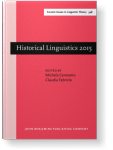Chapter 21
The locative alternation with spray/load verbs in Old English
This paper investigates the locative alternation with spray/load verbs in Old English and the meanings associated with their syntactic variants. The main question addressed is whether in Old English spray/load verbs had the same argument structure realizations as their descendants today. It is shown that not all verbs investigated licensed the locative alternation.
Article outline
- 1.Introduction
- 2.The locative alternation in present-day English
- 3.Spray/load verbs in Old English
- 4.Syntactic variants with spray/load verbs in Old English
- 5.The semantic functions of nominal expressions marked with Accusative, Dative and Instrumental in OE
- 6.Concluding remarks
-
Notes
-
Abbreviations
-
References
